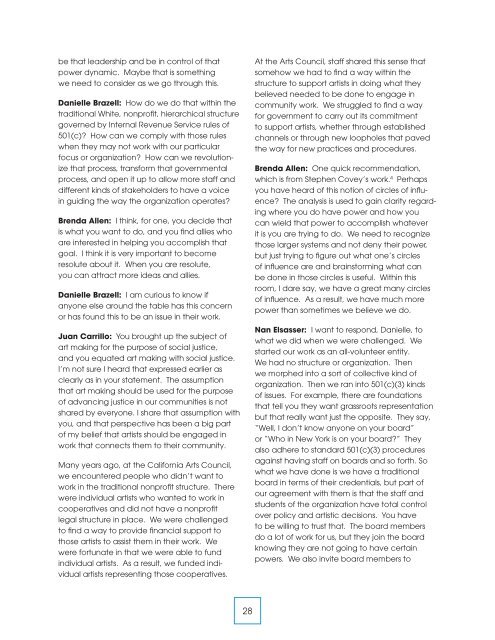The New Face of Arts Leadership in the West - westaf - The Western ...
The New Face of Arts Leadership in the West - westaf - The Western ...
The New Face of Arts Leadership in the West - westaf - The Western ...
You also want an ePaper? Increase the reach of your titles
YUMPU automatically turns print PDFs into web optimized ePapers that Google loves.
e that leadership and be <strong>in</strong> control <strong>of</strong> that<br />
power dynamic. Maybe that is someth<strong>in</strong>g<br />
we need to consider as we go through this.<br />
Danielle Brazell: How do we do that with<strong>in</strong> <strong>the</strong><br />
traditional White, nonpr<strong>of</strong>it, hierarchical structure<br />
governed by Internal Revenue Service rules <strong>of</strong><br />
501(c)? How can we comply with those rules<br />
when <strong>the</strong>y may not work with our particular<br />
focus or organization? How can we revolutionize<br />
that process, transform that governmental<br />
process, and open it up to allow more staff and<br />
different k<strong>in</strong>ds <strong>of</strong> stakeholders to have a voice<br />
<strong>in</strong> guid<strong>in</strong>g <strong>the</strong> way <strong>the</strong> organization operates?<br />
Brenda Allen: I th<strong>in</strong>k, for one, you decide that<br />
is what you want to do, and you f<strong>in</strong>d allies who<br />
are <strong>in</strong>terested <strong>in</strong> help<strong>in</strong>g you accomplish that<br />
goal. I th<strong>in</strong>k it is very important to become<br />
resolute about it. When you are resolute,<br />
you can attract more ideas and allies.<br />
Danielle Brazell: I am curious to know if<br />
anyone else around <strong>the</strong> table has this concern<br />
or has found this to be an issue <strong>in</strong> <strong>the</strong>ir work.<br />
Juan Carrillo: You brought up <strong>the</strong> subject <strong>of</strong><br />
art mak<strong>in</strong>g for <strong>the</strong> purpose <strong>of</strong> social justice,<br />
and you equated art mak<strong>in</strong>g with social justice.<br />
I’m not sure I heard that expressed earlier as<br />
clearly as <strong>in</strong> your statement. <strong>The</strong> assumption<br />
that art mak<strong>in</strong>g should be used for <strong>the</strong> purpose<br />
<strong>of</strong> advanc<strong>in</strong>g justice <strong>in</strong> our communities is not<br />
shared by everyone. I share that assumption with<br />
you, and that perspective has been a big part<br />
<strong>of</strong> my belief that artists should be engaged <strong>in</strong><br />
work that connects <strong>the</strong>m to <strong>the</strong>ir community.<br />
Many years ago, at <strong>the</strong> California <strong>Arts</strong> Council,<br />
we encountered people who didn’t want to<br />
work <strong>in</strong> <strong>the</strong> traditional nonpr<strong>of</strong>it structure. <strong>The</strong>re<br />
were <strong>in</strong>dividual artists who wanted to work <strong>in</strong><br />
cooperatives and did not have a nonpr<strong>of</strong>it<br />
legal structure <strong>in</strong> place. We were challenged<br />
to f<strong>in</strong>d a way to provide f<strong>in</strong>ancial support to<br />
those artists to assist <strong>the</strong>m <strong>in</strong> <strong>the</strong>ir work. We<br />
were fortunate <strong>in</strong> that we were able to fund<br />
<strong>in</strong>dividual artists. As a result, we funded <strong>in</strong>dividual<br />
artists represent<strong>in</strong>g those cooperatives.<br />
At <strong>the</strong> <strong>Arts</strong> Council, staff shared this sense that<br />
somehow we had to f<strong>in</strong>d a way with<strong>in</strong> <strong>the</strong><br />
structure to support artists <strong>in</strong> do<strong>in</strong>g what <strong>the</strong>y<br />
believed needed to be done to engage <strong>in</strong><br />
community work. We struggled to f<strong>in</strong>d a way<br />
for government to carry out its commitment<br />
to support artists, whe<strong>the</strong>r through established<br />
channels or through new loopholes that paved<br />
<strong>the</strong> way for new practices and procedures.<br />
Brenda Allen: One quick recommendation,<br />
which is from Stephen Covey’s work. 4 Perhaps<br />
you have heard <strong>of</strong> this notion <strong>of</strong> circles <strong>of</strong> <strong>in</strong>fluence?<br />
<strong>The</strong> analysis is used to ga<strong>in</strong> clarity regard<strong>in</strong>g<br />
where you do have power and how you<br />
can wield that power to accomplish whatever<br />
it is you are try<strong>in</strong>g to do. We need to recognize<br />
those larger systems and not deny <strong>the</strong>ir power,<br />
but just try<strong>in</strong>g to figure out what one’s circles<br />
<strong>of</strong> <strong>in</strong>fluence are and bra<strong>in</strong>storm<strong>in</strong>g what can<br />
be done <strong>in</strong> those circles is useful. With<strong>in</strong> this<br />
room, I dare say, we have a great many circles<br />
<strong>of</strong> <strong>in</strong>fluence. As a result, we have much more<br />
power than sometimes we believe we do.<br />
Nan Elsasser: I want to respond, Danielle, to<br />
what we did when we were challenged. We<br />
started our work as an all-volunteer entity.<br />
We had no structure or organization. <strong>The</strong>n<br />
we morphed <strong>in</strong>to a sort <strong>of</strong> collective k<strong>in</strong>d <strong>of</strong><br />
organization. <strong>The</strong>n we ran <strong>in</strong>to 501(c)(3) k<strong>in</strong>ds<br />
<strong>of</strong> issues. For example, <strong>the</strong>re are foundations<br />
that tell you <strong>the</strong>y want grassroots representation<br />
but that really want just <strong>the</strong> opposite. <strong>The</strong>y say,<br />
“Well, I don’t know anyone on your board”<br />
or “Who <strong>in</strong> <strong>New</strong> York is on your board?” <strong>The</strong>y<br />
also adhere to standard 501(c)(3) procedures<br />
aga<strong>in</strong>st hav<strong>in</strong>g staff on boards and so forth. So<br />
what we have done is we have a traditional<br />
board <strong>in</strong> terms <strong>of</strong> <strong>the</strong>ir credentials, but part <strong>of</strong><br />
our agreement with <strong>the</strong>m is that <strong>the</strong> staff and<br />
students <strong>of</strong> <strong>the</strong> organization have total control<br />
over policy and artistic decisions. You have<br />
to be will<strong>in</strong>g to trust that. <strong>The</strong> board members<br />
do a lot <strong>of</strong> work for us, but <strong>the</strong>y jo<strong>in</strong> <strong>the</strong> board<br />
know<strong>in</strong>g <strong>the</strong>y are not go<strong>in</strong>g to have certa<strong>in</strong><br />
powers. We also <strong>in</strong>vite board members to<br />
28


